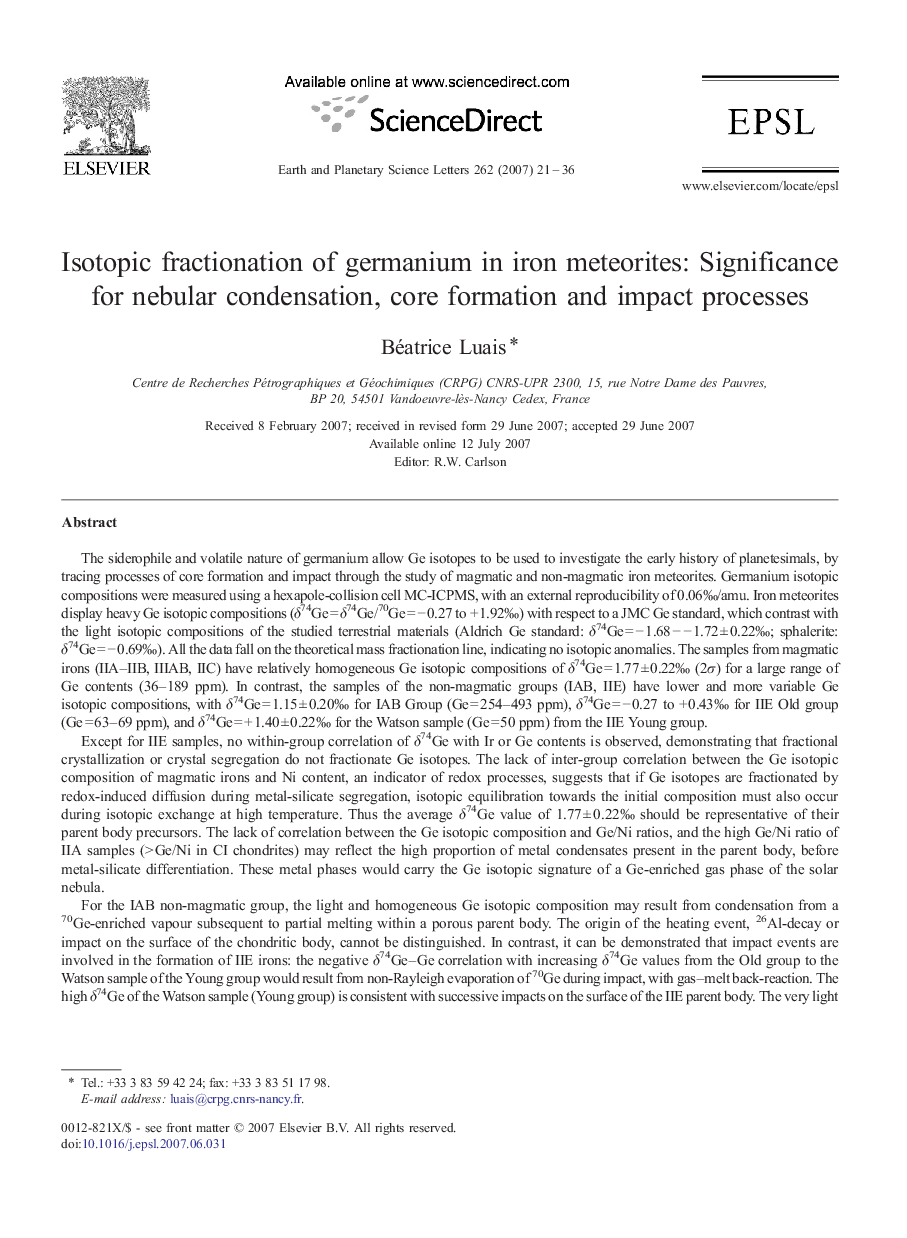| Article ID | Journal | Published Year | Pages | File Type |
|---|---|---|---|---|
| 4680136 | Earth and Planetary Science Letters | 2007 | 16 Pages |
The siderophile and volatile nature of germanium allow Ge isotopes to be used to investigate the early history of planetesimals, by tracing processes of core formation and impact through the study of magmatic and non-magmatic iron meteorites. Germanium isotopic compositions were measured using a hexapole-collision cell MC-ICPMS, with an external reproducibility of 0.06‰/amu. Iron meteorites display heavy Ge isotopic compositions (δ74Ge = δ74Ge/70Ge = − 0.27 to + 1.92‰) with respect to a JMC Ge standard, which contrast with the light isotopic compositions of the studied terrestrial materials (Aldrich Ge standard: δ74Ge = − 1.68 − − 1.72 ± 0.22‰; sphalerite: δ74Ge = − 0.69‰). All the data fall on the theoretical mass fractionation line, indicating no isotopic anomalies. The samples from magmatic irons (IIA–IIB, IIIAB, IIC) have relatively homogeneous Ge isotopic compositions of δ74Ge = 1.77 ± 0.22‰ (2σ) for a large range of Ge contents (36–189 ppm). In contrast, the samples of the non-magmatic groups (IAB, IIE) have lower and more variable Ge isotopic compositions, with δ74Ge = 1.15 ± 0.20‰ for IAB Group (Ge = 254–493 ppm), δ74Ge = − 0.27 to + 0.43‰ for IIE Old group (Ge = 63–69 ppm), and δ74Ge = + 1.40 ± 0.22‰ for the Watson sample (Ge = 50 ppm) from the IIE Young group.Except for IIE samples, no within-group correlation of δ74Ge with Ir or Ge contents is observed, demonstrating that fractional crystallization or crystal segregation do not fractionate Ge isotopes. The lack of inter-group correlation between the Ge isotopic composition of magmatic irons and Ni content, an indicator of redox processes, suggests that if Ge isotopes are fractionated by redox-induced diffusion during metal-silicate segregation, isotopic equilibration towards the initial composition must also occur during isotopic exchange at high temperature. Thus the average δ74Ge value of 1.77 ± 0.22‰ should be representative of their parent body precursors. The lack of correlation between the Ge isotopic composition and Ge/Ni ratios, and the high Ge/Ni ratio of IIA samples (> Ge/Ni in CI chondrites) may reflect the high proportion of metal condensates present in the parent body, before metal-silicate differentiation. These metal phases would carry the Ge isotopic signature of a Ge-enriched gas phase of the solar nebula.For the IAB non-magmatic group, the light and homogeneous Ge isotopic composition may result from condensation from a 70Ge-enriched vapour subsequent to partial melting within a porous parent body. The origin of the heating event, 26Al-decay or impact on the surface of the chondritic body, cannot be distinguished. In contrast, it can be demonstrated that impact events are involved in the formation of IIE irons: the negative δ74Ge–Ge correlation with increasing δ74Ge values from the Old group to the Watson sample of the Young group would result from non-Rayleigh evaporation of 70Ge during impact, with gas–melt back-reaction. The high δ74Ge of the Watson sample (Young group) is consistent with successive impacts on the surface of the IIE parent body. The very light Ge isotopic composition of the Old, less impacted IIE irons compared to other studied iron meteorites suggests a light Ge isotopic composition for the IIE parent body.
